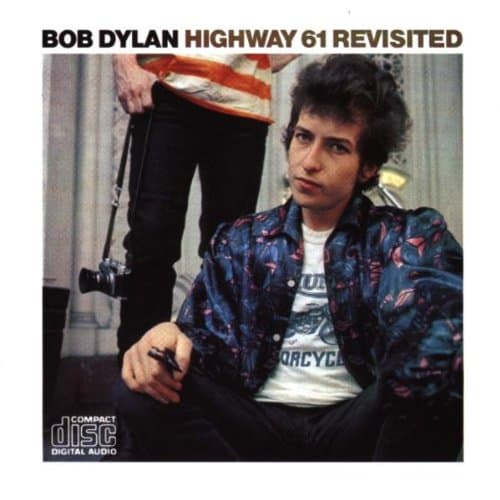
Bob Dylan, Highway 61 Revisited
Value For Money
Bob Dylan, Highway 61 Revisited
When you purchase through links on our site, we may earn an affiliate commission. Here's how it works.

User Reviews
Value For Money
Timeless Classic Album
listen to this on vinyl on a top quality system and nothing is better .I bought this in 1965 and have never tired of it.One of his trio of classics.
Value For Money
This Is Bob Dylan At The Height Of His Lyrical And
This is Bob Dylan at the height of his lyrical and musical powers. The opening and closing tracks, "Like a Rolling Stone" and "Desolation Row" are perfect, and all of the tracks in between are splendid. If I was going to introduce someone to Dylan's music I'd go to this one first before his earlier, more folky work. This album is nothing short of a masterpiece.
Value For Money
Highway 61 Is One Is The Real Bob Dylan Classis. O
Highway 61 is one is the real Bob Dylan classis. Only Blood on the track comes close. It's amazing to realise that only months apart the Beatles came up with Rubber Soul and Revolver, the Beachboys made Pet Sounds and Otis Redding gave us Otis Blue and the Kinks released Face to face. The midsixties are the hayday of Rockmusic and this great album hold proof to that.
Value For Money
'highway 61 Revisited' (1965) Was Bob Dylan's Sixt
'Highway 61 Revisited' (1965) was Bob Dylan's sixth album, and the second on which he used a band, or more specifically, a rhythm section, plus musicians like Al Kooper (organ) and Mike Bloomfield (guitar).
Topped and trailed by two of his most powerful songs ever, it remains one of his defining albums. Alongside its successor, 'Blonde On Blonde' (1966), and moving on a few years to 'Blood On The Tracks' (1975), it's arguably one of the three best he ever recorded.
The opening track, 'Like A Rolling Stone', was a real mould-breaker for its time. Six-minute singles were not the done thing in the summer of 1965 - a single was simply seven inches of black vinyl - but Dylan broke the rules with this astonishingly fierce yet poetic epic. (Significantly, it was his highest-charting single ever - No. 2 US, No. 4 UK). For a long time, critics tried to analyse exactly whom it was directed at, but whether he was having a go at one or two individual acquaintances or just sounding off against the world in general, it hardly matters. That opening slap on the drums, that majestic wash of Hammond organ, that tumbling forth of phrases, and that soaring, searing, 'How does it feel' chorus, all combine to produce something magical.
He's performed it on several of his live albums. But while it's surely a pretty stunning experience to see and hear him perform it onstage (assuming he's having a good night and remembering the words properly), only one other version - that explosive climax to the 1966 live set where he is heckled by a member of the audience and called 'Judas' and snarls out 'I don't believe you - you're a LIAR!' ; over the opening bars - can compare on record with this original, definitive take. (Forget the tired, crowd-pleasing, 1969, Isle of Wight job on the 1970 'Self Portrait' set, which is awful).
'Tombstone Blues' may be poetry, but it's also flat-out garage rock. Much the same can be said about the brisk 'From A Buick 6' and the album's cantering title track, with its galloping piano and police siren wail sound effects. In a way these three tracks are rock'n'roll of a sort, basically only using three chords ('Tombstone' only uses two), but the poetry and imagery of the lyrics elevates them to something else. It's interesting to note that on two subsequent live albums, 'Before The Flood' (1974) and 'Real Live' (1984), he and his bands at the time did full-blown rock versions of 'Highway 61 Revisited', the latter complete with a 'Johnny B. Goode'-style intro.
More measured in musical pace, if not lyrically, are the slower 'It Takes a Lot to Laugh, It Takes a Train to Cry', a rolling blues, the more melodic, enigmatic 'Queen Jane Approximately' and 'Just Like Tom Thumb's Blues'. The ghostly 'Ballad Of A Thin Man' is unsettling with its cynical, pointed refrain, 'Something's happening but you don't know what it is, do you, Mr Jones?'
As a finale, there's the haunting, nightmarish 'Desolation Row'. An 11-minute acoustic work, with just a lightly-picked lead guitar supplementing Dylan's strummed chords and short burst of harmonica. I've seen this ten-verse extravaganza called 'surrealist poetry' - "They're selling postcards of the hanging, they're painting the passports brown." This really is one of his most amazing lyrics ever, full of little stories, descriptions of a nightmare landscape, observations which are surreal, funny, deadly serious and apocalyptic at the same time.
It's probably difficult for the average music punter under 25 to appreciate the full significance of this album. But at the time, it really was a musical milestone. And it was no coincidence that the Beatles and the Rolling Stones also started trying to say much more in their lyrics at around the same time. Robert Allen Zimmerman was indisputably the most influential individual figure in rock music in 1965, bar none. And I wouldn't be surprised if Noel Gallagher, who was born that same year, has paid homage to it either. If so, he's not alone as regards his generation.
Value For Money
Bob Dylan, Highway 61 Revisited - Even If Many Peo
Bob Dylan, Highway 61 Revisited - Even if many people brag about "Blonde on blonde", THIS is the major breakthrough in Dylan music and texts. One of rock's 5 greatest masterpieces !
Q&A
There are no questions yet.